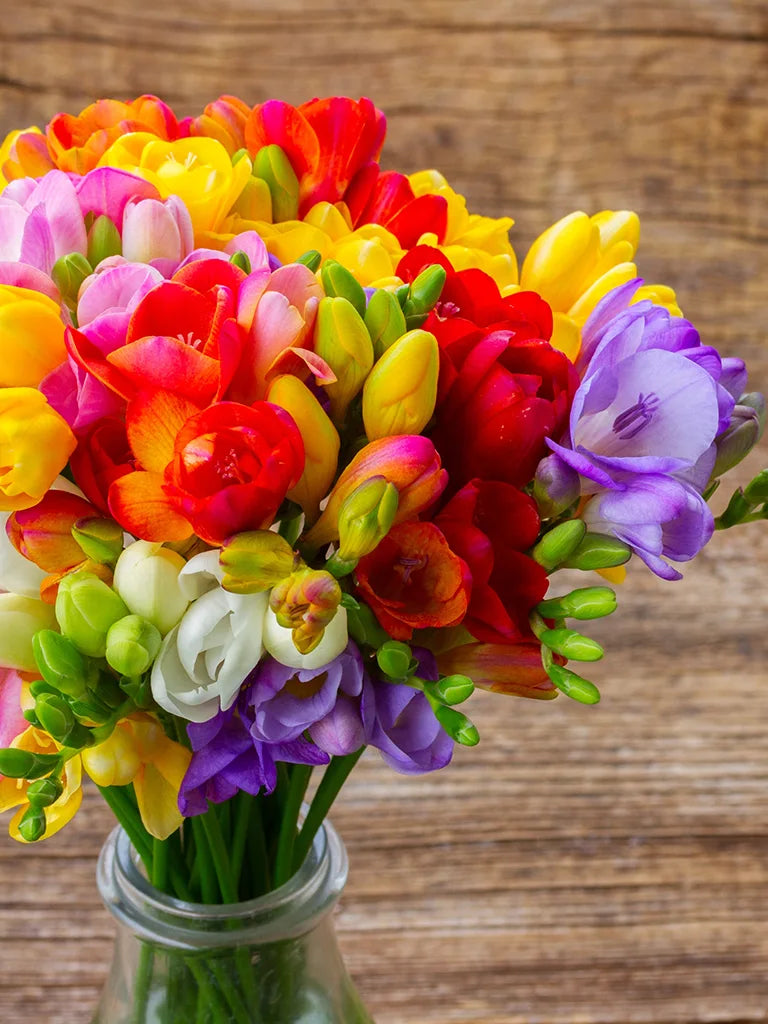Bloemoloog
Organic Freesia 'Mixed' - Cape Lily of the Valley | 10 pcs.
Organic Freesia 'Mixed' - Cape Lily of the Valley | 10 pcs.
Estimated Shipping Widget will be displayed here!
Couldn't load pickup availability
Organic scented freesia
The Freesia, also known as the 'Cape Lily of the Valley', is a summer bloomer that reminds many of grandma's favorite flower, a true retro flower that is still loved for its beauty of color. A striking feature of freesias is their wonderful scent. The flowers emit a sweet, fruity scent that is often described as pleasant and intoxicating, making them excellent as cut flowers.
Each corm produces about five or six narrow, linear leaves and two stems with six to ten flowers each. The flowers grow on a compact, vertical cluster that is borne at the top of the 50 centimeter flower stem and blooms from late June to early August. Freesia flowers have a tubular structure with six petals arranged around a central flower tube. The petals are usually asymmetrical and may be slightly curled, giving them a graceful appearance. The size of freesia flowers varies, but they are usually relatively small and delicate. The petals are elongated and can be about 2.5 to 5 centimeters in length.
Freesias come in a wide range of colors, including white, yellow, pink, red, purple, orange and various shades in between. Some cultivars also have bicolor flowers with colorful contrast.
The fragrant compounds in the freesia are mainly terpenoids. These organic compounds are responsible for the flower's aroma. Specifically, several terpenoids such as benzaldehyde, linalool, geraniol and methyl vanillate have been identified as important contributors to the freesia's scent.
Linalool provides a stress-reducing effect!
Available in 9 different colours.
How, where and when do I plant freesia tubers?
Plant the freesia tubers in groups of several tubers from March onwards. We recommend 20 pieces in a pot with a diameter of 40 centimeters or as needed in the garden, nicely along the paths. The tubers are planted in well-drained soil with the tip pointing upwards. The planting depth is about 2 to 3 times the height of the tuber.
Care of the Freesia
After flowering, the freesia dies completely. The tubers are removed from the ground before frost. Do this by digging around the plant at a depth of approximately 20 centimeters in order to lift the soil around the perimeter to make removing the tubers easier. Clean the tuber by removing all soil and old leaves from around the tuber.
The freesia tubers are kept in a place with room temperature for 3 months in winter. This causes the tubers to produce enzymes, resulting in flowering the following year. If the tubers start growing too early in March due to the heat and you are not ready to plant them, you can store the tubers in a dry and cool place until you are ready to plant them. This way you can enjoy these beautiful colors every year.
Origin of the Freesia
The freesia is originally from Southern Africa, particularly the Cape region of South Africa. The genus is named after the German botanist and physician Friedrich Heinrich Theodor Freese, who first cultivated the plants in the 19th century.
The wild species grow naturally in areas with a Mediterranean climate, where they thrive in sandy or rocky soils. They are found in mountainous areas, grasslands and along river banks. Originally, the flowers of Freesias were usually white or yellow in color.
Today they are widely cultivated in various parts of the world, including the Netherlands, South Africa, Zimbabwe, Kenya and Colombia. The Netherlands is best known for its freesia cultivation and exports large quantities of freesia tubers and cut flowers to various countries.
The original wild species of the freesia can still be found in their natural habitat in Southern Africa. These wild freesias contribute to genetic diversity and serve as the basis for breeding programs to develop new hybrids.
Freesias are often associated with symbols such as innocence, joy and friendship. They are used as decorative flowers on various occasions such as weddings, birthdays and other celebrations.
Buy Organic Freesia 'Mix'
Skal NL-BIO-01 certified: 109459
Packed per 10 pieces or choose a stacking discount!
Stacking discount: E
Delivery within 5 working days!
EU shipping €8.95 - Free shipping from €100 purchase.
Characteristics
| Flowering time: | June - August |
| Planting time: |
From May (or from March indoors) |
| Planting depth: |
8cm deep |
| Planting distance: | 10 cm apart |
| Height: |
50 cm high |
| Flower diameter: | 5cm wide |
| Location: |
Partial shade, sun |
| Soil PH: | Loam, sandy soil - Slightly acidic/neutral |
| Winter hardiness: |
Not hardy |
| Propagation: | Mediocre |
| Origin: | South Africa |
| Family: | Iridaceae (iris family) |
| Colour: | 9 different variants |
| Bee-friendly: | Yes |
| Fragrant: | Yes |
| Bulb size: | 8+ |

NL-BIO-01
To share


















